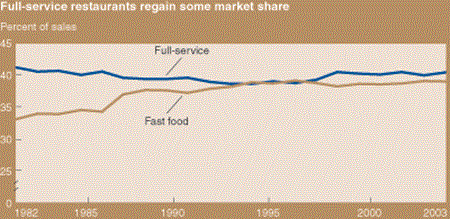Let's Eat Out: Full-Service or Fast Food?

Fast food and full-service restaurants are jockeying for the consumer’s away-from-home food dollar. To win customers, many restaurants of both types are offering dining experiences richer in a variety of foods and services. Applebee’s Neighborhood Grill & Bar, a full-service restaurant, for one, reports that new menu items account for over 50 percent of its offerings. Even some fast food chains, such as McDonald’s, now offer dozens of items on their “limited” menus. Although many factors could be contributing to the evolution of the foodservice industry, these developments point to changes in what consumers are demanding.
ERS research suggests that, between 2000 and 2020, Americans will increase their spending by about 18 percent per person at full-service restaurants, and about 6 percent per person at fast food establishments. These predictions are based on a statistical model that incorporates the changing demographics of the U.S. population—most importantly, rising incomes, a decrease in the proportion of “traditional” households, and an increase in the average age.
If household incomes were to grow by 1 percent annually on an inflation-adjusted basis, by 2020, this development alone would foster a 17-percent increase in per person spending at full-service restaurants and a 7-percent increase at fast food places. Higher income people tend to spend more money on food away from home, especially on full-service dining.
The traditional household, defined as a married couple with children, typically spends less money per person on away-from-home foods than either a single-person household or a household with multiple adults but no children. Traditional families accounted for 30 percent of all households in 1980 and 24 percent in 2000. By 2020, they are expected to account for 17 percent of all households. This change alone will lead to increased spending of 2 percent per person at both full-service and fast food places.
Not all demographic changes bode well for both types of restaurants. The aging of the population is likely to reduce per capita spending by 2 percent at fast food places but to have little effect on the demand for meals and snacks at full-service restaurants.
The Demand for Food Away from Home: Full-Service or Fast Food?, by Hayden Stewart, Noel Blisard, Sanjib Bhuyan, and Rodolfo M. Nayga, Jr. , USDA, Economic Research Service, January 2004


